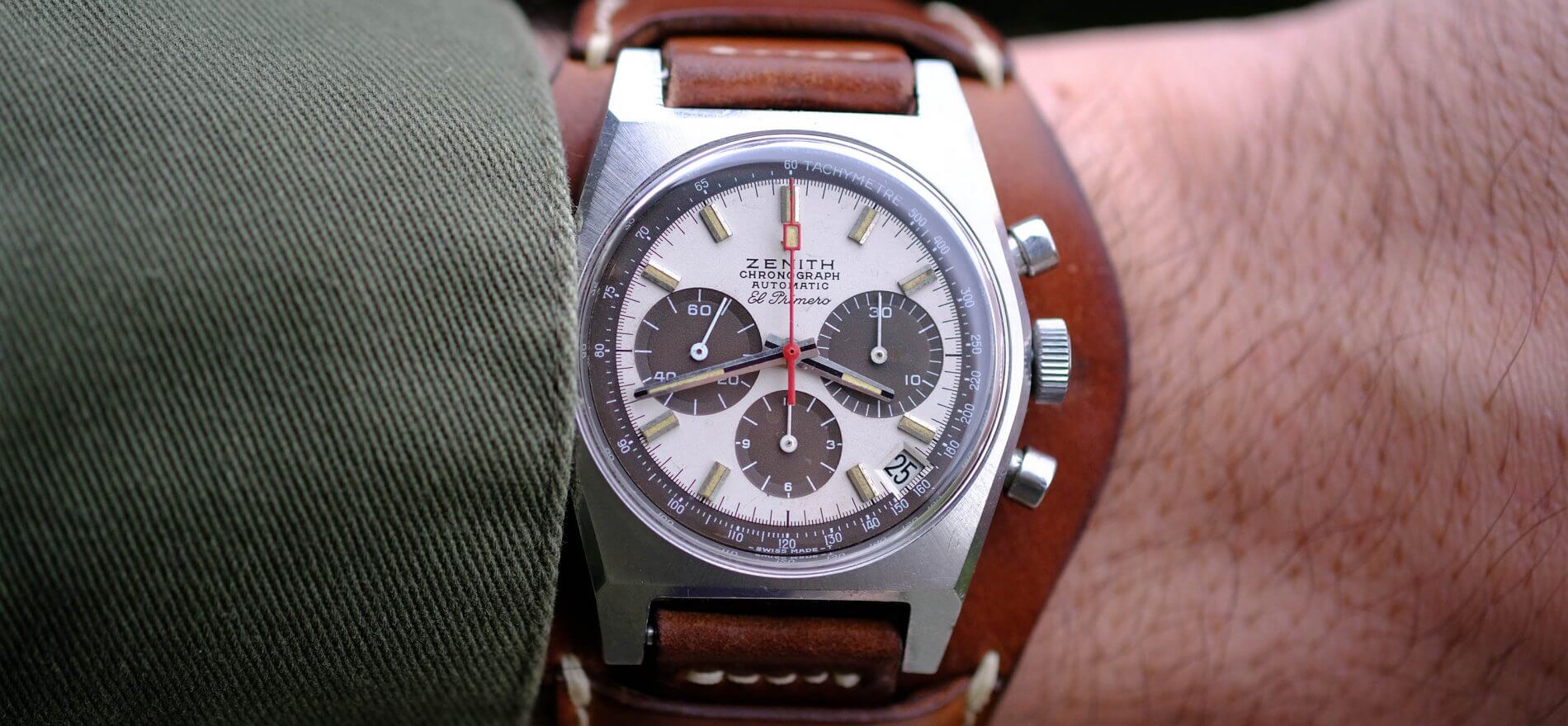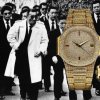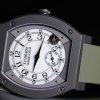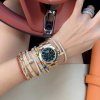As a horophile whose interest in timepieces started with vintage models, I’ve always admired the three-handed “time only” watches in general, and the vintage calatrava models in particular. My interest in the vintage chronographs has always been low. Though I don’t know exactly the underlying reason for this, I think the main reason is that they are relatively complicated and hard-to-repair mechanism in our time. In fact, I’m scared of any possible trouble a vintage chronograph would bring on me. With the time only models, I’m just like a kid playing in his own safe zone. However, I’ve managed to relatively overcome my fear and, last year, I’ve got a clean Poljot 3017 version I’ve been yearning for so long, and since then, my interest in vintage chronographs has been increased. On top of that, when this was followed by the Zenith El Primero A384 of my collector friend I met recently, I’ve found myself lost among El Primero models!

Although the first chronograph models were produced in the first quarter of 1800s, it would still have to take about 100 years for them to take their place on wrists. The watch produced by Longines in order that their bettors could keep their own times is accepted as the first chronograph wristwatch.

By 1960s, there was a felt need to make some improvements, for a more practical and comfortable use, on the chronographs that have been functioning with some changes for nearly 50 years. The first improvement to be realized to meet this need was to make these mechanisms automatically set. Watch companies have already started the research and development studies for it. Indeed, by 1969, 3 different automatic chronograph mechanisms have been presented to the watchmaking world. The first one was the 6139 caliber that was developed by Seiko and was on the wrist of William Pogue during his space mission in 1973, and the second was the Calibre-11 that was a work of a joint venture set up by Heuer, Breitling, Hamilton-Buren and Dubois-Depraz, and the third was El Primero that was developed by Zenith. Although it was the first watch announced as a prototype in January, 1969, Zenith El Primero could hit the marketplace just in the third rank.
Indeed, Zenith hadn’t been assertive at all about the chronographs until El Primero it produced in 1969. Having been producing watches and chronometers for the military units in general during 1940s and 1950s, the company could only make its presence felt on the field of chronographs with the mechanisms it procured from other manufacturers. The fact that it was not a member of the Swiss Chronograph Manufacturers Association at the time was because it had no claim in this field. Having decided to have a say in this field, Zenith improved its expertise and capacity in the field by incorporating the Martel between 1958-1960, a watch company that had an expertise in the world of chronographs and other complicated watch mechanisms, and hence it created from scratch a mechanism such El Primero, with a work directly starting with sketch modelling, without any improvements made on any previous mechanisms.

The most important difference of El Primero from other two chronographs released in the same year was its 5Hz operating frequency. Thus it was able to make 36,000 oscillations per hour. Released after the launch of Girard Perregaux in 1966 and Seiko Lord Marvel in 1967, El Primero made its place in the history of horology as the 3rd hi-beat mechanism. After the initiatives of these 3 brands, the interest in the hi-beat mechanisms has gradually increased. The main reason for the increasing interest in the hi-beat mechanisms was far beyond the desire to have a seconds hand flowing more smoothly. Compared to the so-called low-beat classical mechanisms, hi-beat mechanisms have a capability of a better time-keeping. Hi-beat mechanisms the share, in the time kept by the watch, of the time-unit affected by the factor which affects the watch with a unit of time and this effect of which causes a deviation in the watch’s time-keeping. That is to say; a watch with 18,000 oscillations divides one second into 5, and the one with 36,000 oscillations into 10. With a watch with 18,000 oscillations on your wrist, an instant move increasing the deviation affects 20% of the second on which it is made, whereas this ratio is 10% with a watch with 36,000 oscillations, and hence the effect of the deviation increasing move on the general time-keeping of the watch will be evenly lower.
The world of mechanical watches, which took a major blow, deeply affected Zenith, too. Being sold to Zenith Radio Company, an American firm founded in 1923, Zenith’s overall mechanical watch production was halted. Yet, being informed about this just before the production was completely discontinued, Charles Vermot decided to keep a great many technical drawings and production equipment related to the production of El Primero in a safe place. Himself also being an expert in chronograph mechanisms, you can guess how Vermot acted emotionally in taking this decision. I think that he was not content with such a magnificent mechanical wonder to vanish away. Thanks to this decision of Vermot, when the mechanical watches became popular again in 1980s, Zenith managed to re-start the production of El Primero in the same way with its old and true original without a need to any re-developments.
El Primero was released in 1969 in 3 different cases. These versions were A384, A385 and A386.

The most popular one among these versions was A386 with its 38mm round case, and overlapping colored chronograph sub-dials.

Other versions accompanying A386 were A384 and A385, which were very common during 190s and 1970s, having a case structure called Cushion or Tonneau. Among these versions released in a case 37mm wide and 12,5mm high, and with a Gay Freres signature Ladder bracelet, A384 was quite remarkable and eligible with its panda dial.
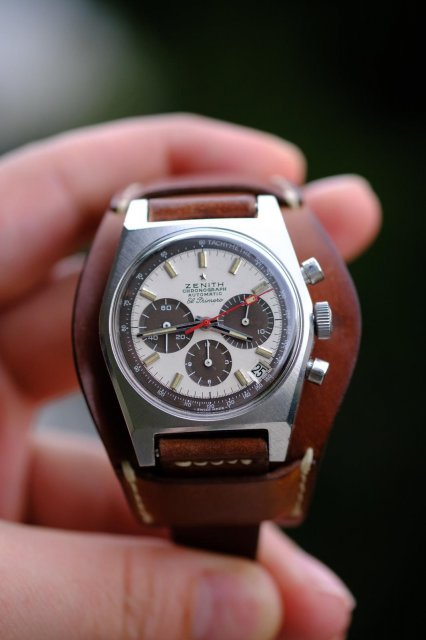
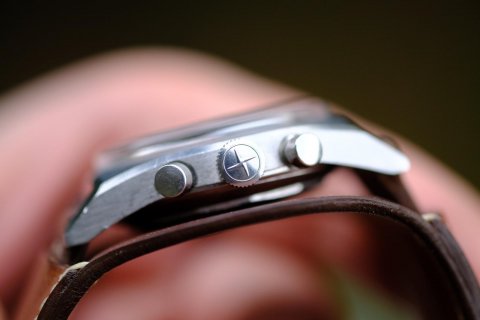
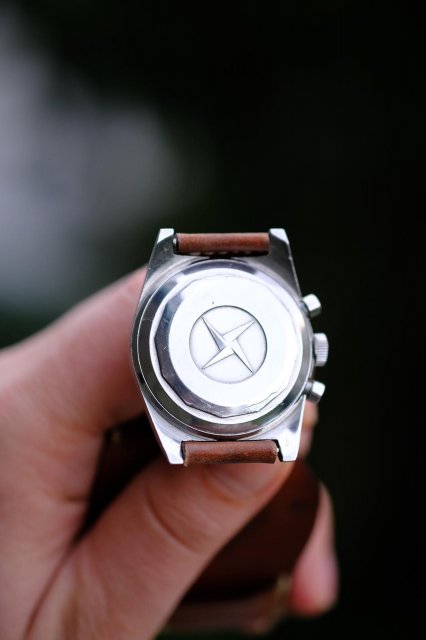
A385s have a totally different story! Due to a defect in the crown gaskets of some A384 lots produced, the dials were damaged, and after these faults were corrected, the overhauled dials were released to the market in graded khaki or cappuccino colors. In the A385 version with these two different tones, chronographs sub-dials were also in two different colors, white and silver. It is estimated that 2,600 pieces of A384 and 2,400 pieces of A385 were produced during 1969-1971. And hence it is understood that the Cushion case El Primero, which was launched in 1969, was produced about in 5,000 pieces in total.

After all this information, when I look at the magnificent A384 sample, which I saw in my collector fellow, and has managed to come with little tiny damages till now from the time of its production, I saw that something much more than a 50 years-old watch stands in front of me. Although its original Ladder bracelet couldn’t manage to come till now with it, what is facing us is not an ordinary old watch with its chronograph sub-dials that bear the traces of the time and have now turned into brown under the effect of the sun, and its radium phosphors that are unable to emit light though they are still radioactive just like the first day, and above all, its mechanism which is the first automatic chronograph mechanism in the world; it is nothing short of a meritorious horological milestone.

